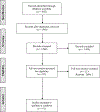Relationship between ankle function and walking ability for children and young adults with cerebral palsy: A systematic review of deficits and targeted interventions
- PMID: 34736095
- PMCID: PMC8671343
- DOI: 10.1016/j.gaitpost.2021.10.024
Relationship between ankle function and walking ability for children and young adults with cerebral palsy: A systematic review of deficits and targeted interventions
Abstract
Background: A primary goal of treatment for children with cerebral palsy is improved walking ability to allow for a more active and independent lifestyle. With the importance of ankle function to walking ability, and the deficits in ankle function associated with cerebral palsy, there is good rationale for targeting this joint in an effort to improve walking ability for this population.
Research question: How do deficits and targeted interventions of the ankle joint influence walking ability in children with cerebral palsy?
Methods: A specific search criteria was used to identify articles that either (1) provided information on the relationship between ankle function and walking ability or (2) investigated the effect of a targeted ankle intervention on walking ability in cerebral palsy. PubMed, Embase, CINAHL, and Web of Science databases were searched from 1980-April, 2020. Resulting citations were compared against a prospective set of inclusion and exclusion criteria. Data relevant to the original research question was extracted, and the level of evidence for each intervention study was scored. Interpretation was focused on specific, pre-determined mobility measures.
Results: Sixty-one citations met all criteria for data extraction, six of which were observational, and fifty-five of which were interventional. Level of evidence ranged from 2 to 4. Self-selected walking speed was the most common measure of walking ability, while physical activity level was the least common.
Significance: Ankle function is an important contributor to the walking ability of children with cerebral palsy, and most interventions targeting the ankle seem to demonstrate a benefit on walking ability, but future higher-powered and/or controlled studies are necessary to confirm these findings.
Keywords: Ankle joint; Cerebral palsy; Systematic review; Walking ability.
Copyright © 2021 Elsevier B.V. All rights reserved.
Conflict of interest statement
Figures



References
Publication types
MeSH terms
Grants and funding
LinkOut - more resources
Full Text Sources
Medical
Miscellaneous

